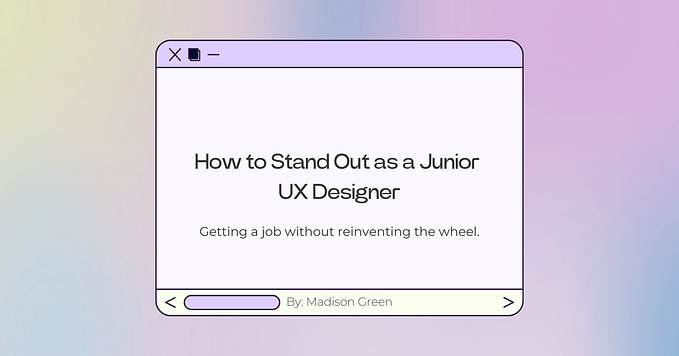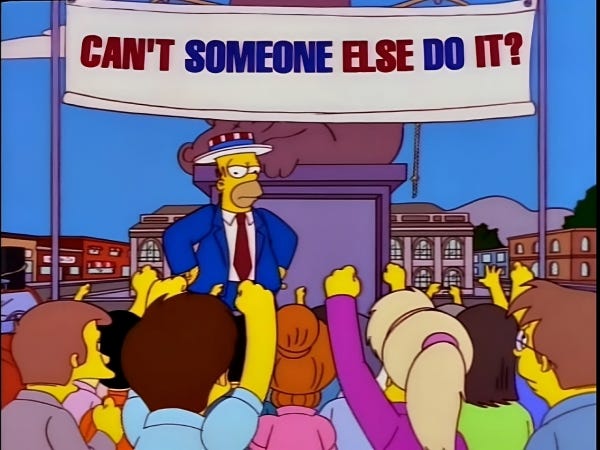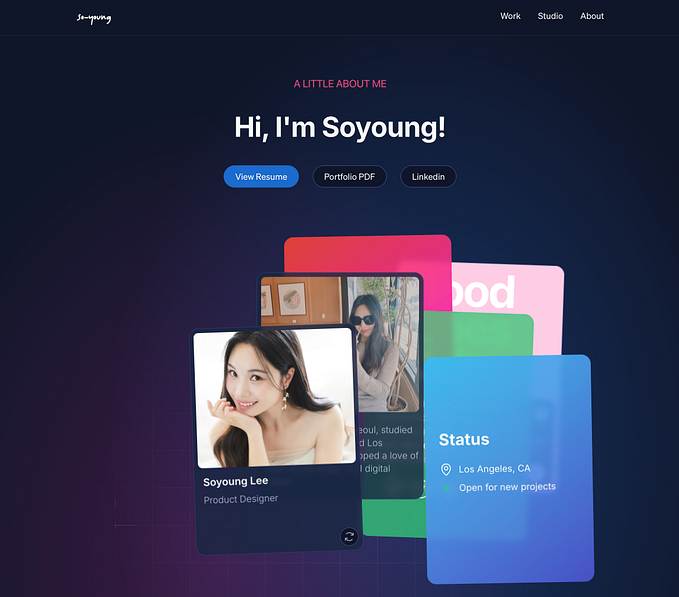How I landed a UX/UI Design job with no prior experience or related degree

Shortly after finishing High School, I enrolled in a Computer Science course. I was ambitious, ready to burn the midnight oil and learn all about programming and data science. After a year of continuous studying, I was burnt out and felt like I was doing something only because being a programmer would mean having an amazing salary in the future.
Therefore, I decided to focus on what I love, fulfil my long life dream and move to the United States to study & play tennis. I was offered an academic and athletic scholarship in Philadelphia, USA. It was a dream come true. I always saw myself working in the sports industry, therefore I enrolled in Business Administration & Sports Business courses.
While I failed to find a job in the sports industry, I thought that designer life is much more in demand and it’s something I felt passionate about. Therefore, during my second year, I started learning more about the design industry, and specifically — UX/UI design.
I finally knew what I wanted to do. In order to speed up my graduation, I transferred to a University in London for my final year and graduated in July 2019 with a Sports Business degree. I have found my first full-time job in April 2019 (yes, while still studying).
Figure out why you want to work as a UX/UI designer.
To me, being a designer means that I could work from home whenever I feel like while travelling around the world. At least that’s what I imagined and pushed for.
While working as a tennis coach during my student life, I had a client that wanted me to do design work for him. I shared my portfolio and a business card with him. This is how I found my first client. Woohoo!
Working as a freelancer is amazing. As long as you have clients and work to do. At some point, I felt like I wasn’t capable of finding new clients and started looking for a full-time job/internship.
During my job search, I started reading stories of how it is to work at all those great companies. I started asking myself whether I’d like that corporate day-to-day routine? Would I have enough flexibility to work from home whenever I need to? Are there growth opportunities? Does the lifestyle match my working routine?
After talking to multiple people from tech-industry, and taking part in UX/UI Masterclass meet-ups, I was convinced that product design career is the way to go. It entails creativity, problem-solving, and analytical thinking that makes me very passionate about the topic. Design is a part of people’s daily lives, and doing product design means playing a role in these lives.
Step 1: Build a Portfolio
In order to find ANY job in the design industry, you must have a portfolio. UX/UI folios usually follow this structure:
- Overview
- Short Story with Key Findings:
- The challenge
- Solution
- Outcome - Research:
- User Interviews
- User Stories
- User Personas
- User Scenarios (Blimey so many ‘Users’!)
- Site Map - Design Phase
- Sketches
- Low-Fidelity Wireframes
- High-Fidelity Wireframes
- Usability Testing
- Prototyping
- Further Improvements/ Lessons Learned
You can do real client work (aka freelance) on the side, build your own apps, take part in hackathons, and re-design apps. There’s no really a right and wrong answer to what you should include. I’d say focus on your 4–6 best projects.
You can check out the example here: https://www.nicolaguzowska.com/coffee-me-app-design
Tools I used:
For product design portfolio inspiration, I used Bestfolios — the largest curation of best UI/UX designer portfolios, resumes, case studies and design resources. They are absolutely killing it!
At the beginning of my career, I purchased RokkieUp UX/UI design course. I received a syllabus consisting of hundreds of dropbox files and documents with the course but it quickly became overwhelming (I never started them). I prefer step-by-step video courses. I heard really good feedback about them tho! They also provide mentors (I booked a session with a Microsoft designer, yay!), folio feedback, and real client projects which is superb.
Besides, I purchased multiple Udemy courses. They have courses from UX, UI, motion design, prototyping and whatever you need! I discovered that sometimes the same courses are at Skillshare which can save you a few dollars!
I built my website using Squarespace. They have award-winning templates. You can build your folio using a drag and drop feature and edit it further in CSS.
My folios:
www.websi.design
www.nicolaguzowska.com
Step 2: Build a CV that CONVERTS (use the X by Y by Z formula).
Example of my current CV: here for inspiration.
I can’t recall how many times I edited my CV. Not only visuals but also the content. For some reason, I thought that recruiters and employers don’t put too much attention to the description of each job. Therefore I didn’t put much effort into it. But I was WRONG.
Google X by Y by Z formula:
Everything changed when I read an article about Google resume X by Y by Z formula. I suddenly started getting about 200% more calls from recruiters. I was also being invited to an on-site interview MUCH MORE often.
Google describes this as: “Accomplished [X] as measured by [Y], by doing [Z].” But just to make it easier to remember, let’s shorten it to X-Y-Z.
Here’s a quote from the original article:
‘For example, imagine an applicant who wants to make clear that he or she is a member of a prestigious group. Here’s the OK way, the better way, and the best way to describe this on a resume, according to Google:
- OK: “Member of Leadership for Tomorrow Society”
- Better: “Selected as one of 275 for this 12-month professional development program for high-achieving diverse talent.”
- Best: “Selected as one of 275 participants nationwide for this 12-month professional development program for high-achieving diverse talent based on leadership potential and academic success.” ’
Check out portfolios from people that work at Google, Facebook, Microsoft etc. here!
Step 3: Build your LinkedIn profile
This is how I found my first full-time job! Make sure you are open to opportunities. Craft your profile nicely so it looks professional. Recruiters will start reaching out to you, instead of you contacting them! It will save you lots of time in the job search.
My LinkedIn profile is here.
Step 4: Apply for jobs
Prepare for rejections. It will hurt… ouch! It is a ruthless process. Don’t worry if a company or a recruiter ghosts you — it happens to all of us and is part of the process. It’s easy to burn out. I felt extremely anxious and questioned my skills all the time. Stay stubborn, and remember why you’re doing this!
It may take a few weeks or even months until you sign a contract. Remember that each company looks for different skills and experience. I was a part-time tennis coach during my process which helped me pay my bills. I also looked for contract roles in the meantime. But we’re all different. Stay brave and remember, that what doesn’t kill us makes us stronger. Think positive!
I used the following sites to look for jobs:
- https://www.linkedin.com/
- Google jobs search engine (this one is my favorite since you can customize it and see when a job was posted)
- https://www.glassdoor.co.uk/index.htm
A few tips:
- create an excel file and write down where you have applied
- track the file, write down dates, progress, etc.
- write down what works, what doesn’t, and improve!
Step 5: Prepare for job interviews
Make sure you researched the company and know basics of what they’re doing and how they’re making money! They will most likely ask you what their company does and why you want to work there. Make sure you have a few questions prepared to ask them. Sound genuinely interested and excited about their work (even if you aren’t)!
Before the interview: research the company.
The research will give you confidence should you be asked a question about your understanding of what the company does. It will also allow you to ask questions to the potential employer.
It may be helpful to find out the following things about business:
• What do they do, make or sell?
• Who are their customers?
• What is the job likely to involve?
• How can you best fit your skills to match the job?
During the interview
Be aware of your body language and non-verbal communication, which is as important as your verbal communication, employ active listening behaviors such as eye contact and nodding.
Questions you may be asked
• What are your reasons for considering a career move?
• What attracted you to this particular role?
• You may be asked to illustrate your achievements in your current and previous roles.
• Illustrate why you wish to join this company in particular
• Make sure you have a coherent vision of where you would like to be in three years’ time.
Based on the above, be prepared to provide behavioral answers using the STAR method:
• The situation, in which the behavior took place
• The task, what it is that you did
• The approach, how you went about managing the situation
• The result, the consequences resulting from your behaviors and actions
Example questions you may like to ask towards the end of the interview:
• Based on my background and experience, what do you think would be the greatest challenges for me in this position?
• What is the team dynamic and structure, and in your opinion, would I be a good fit?
• Is there much scope for career progression?
• Where is the business heading?
Ending the interview
- Thank the interviewer for their time
- Express an interest in the continued relationship with them and the company, leave on a positive note
- Enquire about next steps in the process and the timeline for receiving feedback
- Don’t be afraid to ask whether based on this interview, the interviewer feels you could be successful in the position, and when will you find out regarding whether you will be progressed through the interview process
Step 6: Land a Job & Never Stop Learning!
No-one said that landing a job is easy. It is not!
Remember to keep learning. Take part in design meetups, UX/UI Masterclasses, meet people from the industry, socialize!
Go-to online resources:
UX/UI Online Groups:
- Designers Guild on FB. Invite only.
- Opsididitagain on Slack. Invite only. We’re a social and active UX/UI designers located in London. Reach out if you’d like to join us!
- The Intrapreneurs Club. We have weekly masterclasses to help us track our growth, and listen to inspiring stories from UX/UI industry leaders!
Medium writers I actively follow:
- Pablo Stanley. Designer at InVision.
- Julie Zhuo. VP of Product Design at FB.
When one door closes, the other one opens! Stay positive and embrace the transition and the process. Do not be afraid to fail. And get used to the fact that your portfolio will never be finished. Yikes!
I’m a UX Designer based in London. You can book a 1:1 time with me for a portfolio review or to get more advice on breaking into UX/UI!
For more info, check out my Patreon page: https://www.patreon.com/nicolaguzowska.
Connect with me on Instagram








